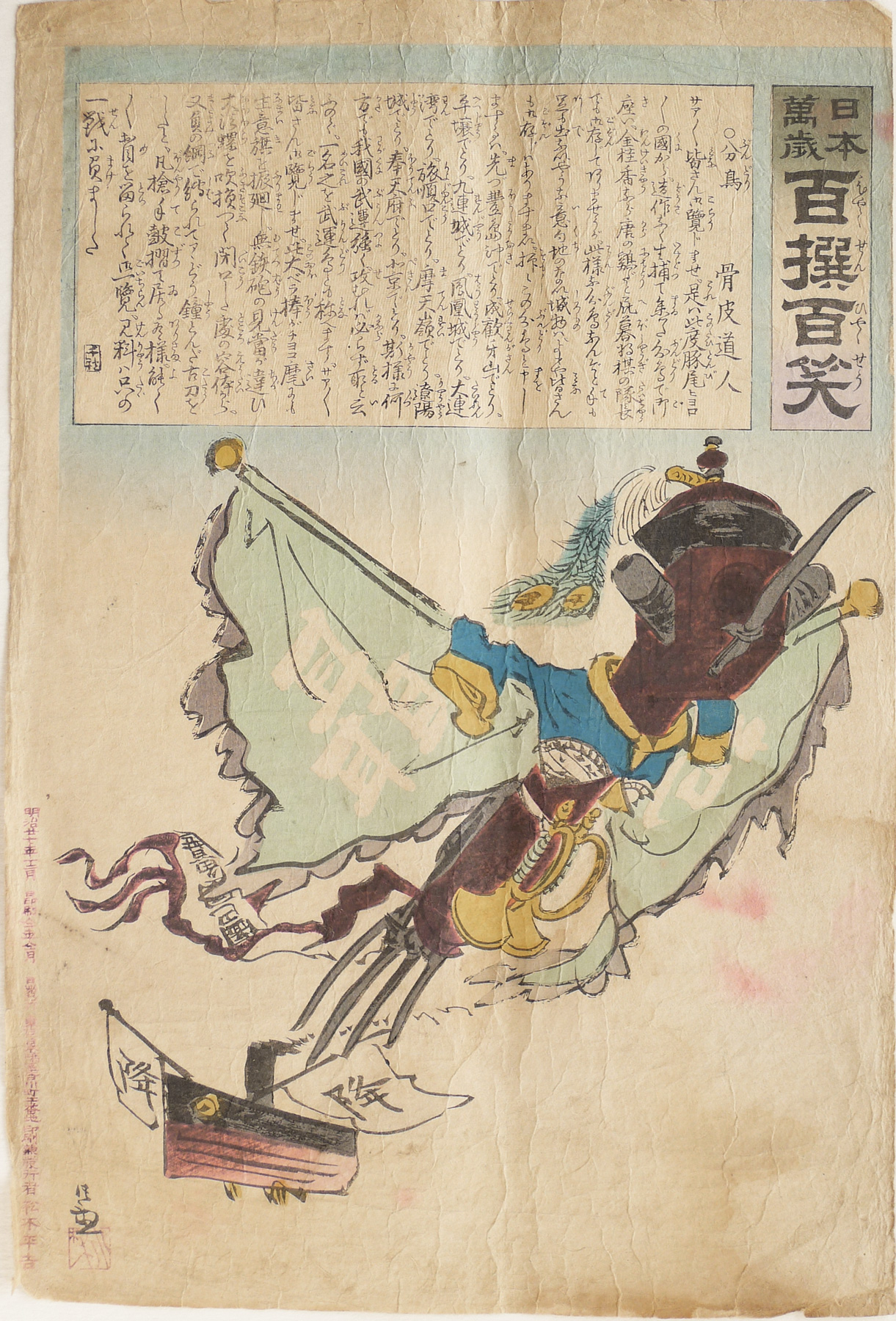About This Print
This print is one of fifty prints from the first part of the three part series One Hundred Victories, One Hundred Laughs. (Hyakusen hyakushô) created by the artist Kobayashi Kiyochika (1847-1915), the writer Nishimori Takeki (1861-1923), alias Koppi Dōjin, and the publisher Matsuki Heikichi (1870-1931).
About The Series One Hundred Victories, One Hundred Laughs
This series One Hundred Victories, One Hundred Laughs was issued in three parts and presented parodies of the enemy, the Chinese in the Sino-Japanese War of 1894-1895 and ten years later the Russians in the Russo-Japanese War of 1904-1905. The first part of the series titled Long Live Japan: One Hundred Victories, One Hundred Laughs, consisting of fifty prints, was issued between September 1894 and August 1895. The second part of the series titled Magic Lantern Society: One Hundred Victories, One Hundred Laughs, consisting of twelve prints, was issued between November 1895 and December 1896. Both of these parts parodied (often in a racist manner) the Chinese people, leadership and war effort. The third and last part of the series, consisting of eight-six prints, used the same title as the first part Long Live Japan: One Hundred Victories, One Hundred Laughs. Issued between April 1904 and April 1905, the prints parodied the Russian war effort. For more information about the series see the article One Hundred Victories, One Hundred Laughs on this site.
サアサア皆(みな)さん御覧(ごろう)じませ、是(これ)ハ此度(このたび)豚尾(とんび)もコロ/コロの国から造作(ぞうさ)なく生捕(いけどつ)て参(まい)つた分鳥(ぶんどり)で御(ご)/座(ざ)い、全桂香(ぜんけいきやう)なら唐(から)の鶏(にわとり)よと屁忘将棋(へぼしやぎ)の隊長(たいちやう)/ でも御存(ごぞん)じでありませうが、此様(こん)な分鳥(ぶんどり)なんぞと手も/ 足も出(で)ないやうな意気地(いくぢ)のない城物(しろもの)ハよもや皆(みな)さん/ も御存(ごぞん)じハありますまい、抑々(そもそも)この分鳥(ぶんどり)と申(もを)し/まするい、先(ま)づ豊島沖(ほうとうおき)でとり成歓(せいくわん)牙山(がざん)でとり、/ 平壌(へいじやう)でとり、九連城(れんじやう)でとり、鳳凰城(はうおうじやう)でとり、大連(たいれん)/湾(わん)でとり、旅順口(りよじゆんこう)でとり、摩天嶺(まてんれい)でとり遼陽(りやうやう)/城(じやう)でとり、奉天府(ほうてんふ)でとり、北京(ぺきん)でとり、斯様(かやう)に何(いづ)/方(かた)でも我国(わがくに)の武運(ぶうん)続(つづ)く、攻(せ)むれバ必(かな)らず取(とる)と云(い)/ふので、一名(めい)之(これ)を武運鳥(ぶうんどり)とも称(とな)へます。サアサア/ 皆(みな)さん御覧(ごらう)じませ、此(この)大(おほ)べラ棒(ぼう)がチョコ犀(さい)にも/生意旗(なまいき)を振廻(ふりまわ)し、無鉄砲(むてつぱう)の見當(けんとう)が違(ちが)ひ/ 大法螺(おほぼら)を吹損(そこな)つて閉口(へいこう)した処(ところ)の容体(えうたい)なり。/ 又負(まけ)の綱(つな)で縛(しば)られてアアどう鐘(しやう)どんだ古刀(ことう)を/ したと、凡槍手鼓摺(ぼんやりてこずり)て居(い)る有様(ありさま)能(よ)く/能くお目(め)を留(とどめ)られて御一覧(ごいちらん)、見料(けんりやう)ハ只(ただ)の / 一戦(せん)に負(まけ)ました
Bundori Koppi Dōjin [分鳥 骨皮道人]
Sā sā mina-san go-rōjimase, kore wa konotabi tonbi mo koro/koro no kuni kara zōsa naku ikedotte maitta Bundori de go/zai, Zenkeikyō nara Kara no niwatori yo to hebo-shōgi no taichō/ demo go-zonji de arimashō ga, konna Bundori nan zo to te mo / ashi mo denai yō na ikuji no nai shiromono wa yomoya mina-san/ mo go-zonji wa arimasumai, somosomo kono Bundori to mōshi/masu rui, mazu Hōtō-oki de tori Seikan Gazan de tori,/ Heijō de tori, Kyūrenjō de tori, Hōōjō de tori, Tairen/-wan de tori, Ryojun-kō de tori, Matenrei de tori, Ryōyō/jō de tori Hōten-fu de tori, Pekin de tori, kayō ni izu/kata de mo wagakuni no buun tsuzuku , semereba kanarazu toru to i/u no de, ichimei kore o Buundori to mo tonaemasu. Sāsā/ mina-san go-rōjimase, kono ōberabō ga chokozai ni mo/ namaiki o furi mawashi, muteppō no kentō ga chigai/ ōbora o fukisokonatte heikō shita tokoro no yōtai nari./ Mata make no tsuna de shibararete ā dō shiyō tonda koto o/ shita to, bonyari tekozurite iru arisama yoku/ yoku o-me o tomerarete go-ichiran, kenryō wa tada no/ issen ni makemashita.
Print Details
| IHL Catalog | #1064 |
| Title or Description | The Plunder Bird [also translated as The Snatching} Bundori 分鳥 |
| Series | Long Live Japan: One Hundred Victories, One Hundred Laughs [also translated as Long Live Japan! One Hundred Selections, One Hundred Laughs] Nihon banzai: Hyakusen hyakushō 日本萬歳 百撰百笑 [日本万歳 百撰百笑] |
| Artist | Kobayashi Kiyochika (1847-1915) |
| Signature |  |
| Seal | Kobayashi (see above) |
| Publication Date | December 1894 (Meiji 27) 明治廿七年十二月 日印刷 |
| Publisher | Matsuki Heikichi (松木平吉) proprietor of Daikokuya |
| Impression | excellent |
| Colors | excellent |
| Condition | poor - heavy wrinkling and soiling throughout; offset ink stains; faded; full-size and not backed |
| Genre | ukiyo-e - senso-e (Sino-Japanese War); giga, fūshiga |
| Miscellaneous | |
| Format | vertical oban |
| H x W Paper | 14 7/16 x 9 5/8 in. (36.7 x 24.4 cm) |
| H x W Image | 13 7/8 x 9 1/8 in. (35.2 x 23.2 cm) |
| Literature | |
| Collections This Print | British Library shelfmark:16126.d.2(32); The Tsubouchi Memorial Theatre Museum of Waseda University 012-1065 and 012-1032; Princeton University Art Museum 2008-102.37 |


